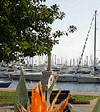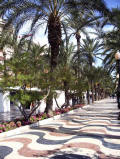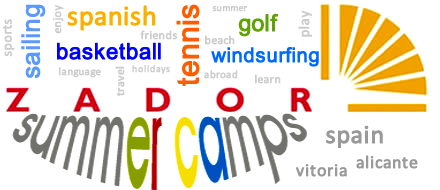Alicante, all in all a Mediterranean city in Spain
.JPG)
Alicante offers you an eminently Mediterranean land-scape. There are kilometres of coast combined with enormous coastal plains and mountains where you can enjoy the excellent climate all year round. Big cities and tourist centres with all kinds of services and activities mix with small and quiet villages, that have preserved their millenniums of history and culture, but at the same time stay open to the future.
If diversity is what you are looking for in your Spanish immersion courses in Spain, you will find plenty of it in Alicante, in the Costa Blanca region.
Alicante combines classicism with modernity, leisure with business, fun with study, and even mountain and beach. The richness of Alicante's history is preserved through its archaeological remains. The beauty of its monuments along with the charm of various festivities and cultural events held throughout the year increase the appeal of the city.
The wonderful beaches and mild climate all year round make Alicante one of Spain’s most important tourist areas.
All in all, Alicante is a Mediterranean city.
|
Alicante and Costa Blanca region Overview |
| |
Alicante Location |
|
Population |
 |
In the South part of the Valencia Region, Alicante is located 185 Km from Valencia, 60 Km from Elche, 515 Km from Barcelona and 422 Km from Madrid.
Alicante, on the Mediterranean Cost, is dominated by the two castles of Santa Barbara and San Fernando. From the top of their rocky peaks, they seem to keep an eye on the city, whose houses are spread over the hills, gently sloping towards the sea, the harbour, the beaches and the coves: San Juan, the Albufereta, Cocó, Postiguet and Saladar beach to the south. |
 |
With around 300,000 inhabitants, Alicante is a prosperous city, attracting people from different regions in Spain and Europe. Alicante has grown a lot thanks the continuous expansion of its dynamic services sector.
|
| |
How to get Alicante |
|
Alicante tourist information |
 |
There are train and bus stations, a harbour and an international airport. The A-7 toll motorway connects Alicante to all the Mediterranean coast cities. There is also a highway to Madrid. Bus and train lines link Alicante to all these cities. Airlines offering both regular and charter flights connect Alicante with the main European cities.
Alicante has three train stations: Renfe station is the main train station in Alicante, for national and international connections. FGV train station for local and coastal destinations, with train from Alicante to Benidorm, Denia, Xativa... and Murcia train station.
Check train's timetable and prices from and to Alicante on the INTERNET SITE of RENFE: www.renfe.es You can also call: +34 902 240 202 for booking and information on prices and destinations, and +34 93 490 11 22 for international information.
From Madrid -Atocha train station- to Alicante: many trains daily. It takes about 3 hours 30 minutes.
From Barcelona -Sants train station; address Pl. Països Catalans, s/n- to Alicante: many trains daily. It takes about 4 h 30 min. Alicante train station is located in the center of the city - Avenida de Salamanca, 1. (5 –7 minutes on foot from Zador Spanish language school).
Alicante flights (El Altet airport) Distance: The Alicante airport is located 11 km from Alicante by the N-332 road. There are domestic and international flights connect Alicante to the main European and Spanish cities (Madrid, Barcelona, Bilbao, etc). Both regular and charter flights available.
Alicante airport telephone number: + 34 966 91 90 00.
There are buses every 40 minutes (from 7:00am to 11:00pm) from Alicante airport to the center of Alicante (Bus stop at the exit of the terminal; the bus goes till the Plaza del Mar – last stop). It takes about 20-30 min.
|
 |
If you go up to the top of the hill of the Santa Barbara Castle, you will discover an unforgettable panoramic view of the most important monuments in Alicante: the church of Santa Maria, the Cathedral, the Town Hall façade, the monastery of Santa Faz, the San Fernando Castle and much more.
Seeing all these magnificent monuments from above will invite you to go down the hill and walk along them. Along the streets, you will come across large and small palaces, as well as traditionally painted white, yellow and pink houses.
Everything is illuminated by the blue light of the Mediterranean Sea and encourages you to continue walking around and discovering places.
You can find the old Mercy House, the Asegurada House, where nowadays the Contemporary Art Museum is situated, the Marquis del Bosch palace, the Quijano Pantheon, with its romantic garden, the House of the Witches or the Alberola House.
The widest avenues, such as La Rambla or Doctor Gadea will lead you to Alfonso X el Sabio (Alfonso the wise) Street with the Luceros (Creole fish) on one side and the Central Market on the other, just in front of the Zador Spanish language school.
This area, including Maisonnave Street, is the most commercial part of the city, where you will see many people shopping.
After so much walking, you will be ready to sit at one of the many outdoor cafés. You can also relax on the benches of the oceanfront promenade or sit on the chairs in the Explanada (forecourt) de España and watch the masts of the boats in the harbour, the constant movement of the waves on the beach, the people going to and from... |
| |
Alicante social life |
|
Surrounding cities |
 |
There are many leisure areas where the most varied entertainment is guaranteed.
In El Barrio, the name of the old town, there is a high concentration of bars and restaurants with excellent atmosphere, as well as some places with live music.
Some must-see stops are: La Zona, just behind the Explanada (forecourt), which is for the young and lively crowd, or la Ruta de la Madera, behind Alfonso el Sabio Avenue and El Puerto, with their more modern spots, discotheques and out-door cafés.
Traditional fiestas, festivities and events
If you take part in the Alicante fiestas and festivities you will enjoy truly magic moments.
Among the Alicante fiestas, we recommend the pilgrimage of Santa Faz or the processions of Moors and Christians, the Porrate of Saint Anthony around the 17th of January with its stands in the streets, the processions of Saint Nicholas, or the Carnivals.
June is a very special month in Alicante: On June 24th, the eve of San Juan, or Saint John, traditional bonfires are lit all over Alicante and the streets filled with music, celebration and fireworks. Huge papier-mâché; monuments are consumed by the flames during the purifying rituals of this magical night.
And these are only some of the most significant fiestas in Alicante.
There are many others celebrated throughout the year. All year round Alicante offers you an extensive cultural programme. You can choose among a variety of concerts, conferences, theatrical productions or a medieval market at the end of June. T
here is also a summer festival on the forecourt of the harbour with its theatre plays and concerts. Do not forget the nights of the Castle, the International Festival of Contemporary Music or the International Puppets Festival. |
 |
The biggest city is Valencia, founded in the 2nd century B.C. Many historic events have left their imprint throughout the centuries and enriched the heritage of this city. Nowadays, it has become one of the most important Spanish cities in the cultural and economic fields. It is also the capital of the Community of Valencia. A tour around the centre of the city will bring you closer to its history and some of the monuments like the Town Hall, the Post office building, the church Saint John of the Cross or the market of Christopher Columbus. The coastal road will lead you to the harbour, to the Fish Market, or to the Royal Atarazanas (famous building) and the oceanfront walkway. If you are attracted by modernity, visit the Valencia of the Third Millennium, with architecturally impressive City of Arts and Sciences.
In Elche - 60 km from Alicante, you can walk round the largest palm forest in Europe, declared Common Natural Heritage.
In Orihuela you can see the largest monumental grouping in the province – the gothic Cathedral of El Salvador (The Saviour), the Churches of San Jaime, Santa Justa (Just) and Santa Rufina, and its palaces and museums among palm trees.
Benidorm is located 42 km up the coast to the north. It is the best tourist-town in all the Mediterranean. The excellent beaches of Levante and Poniente, the cafés, pubs and discotheques and the great Terra Mítica amusement park will guarantee your fun.
Further up North, you will find the charm and class of Calpe, in the shadow of the Peñón de Ifach. Javea and Dénia are also worth a visit for the beauty of their old town- centres and beaches.
Towards the South, the coast is flatter and there are extensive sandy areas and wetlands. Alongside Santa Pola beach, the Guardamar dunes and pine forest will lead you to Torrevieja, a tourist centre in the South of the province.
Inland, you must visit Guadalest – a typical town set in a dream-like landscape.
Take the route of the castles and visit the La Mola Castle in Novelda or the La Atalaya Castle in Villena. The farthest one is Bañeres Castle, 82 km from Alicante.
|
| |
Alicante, mild climate all year round |
|
Alicante cuisine |
 |
Alicante in Costa Blanca area enjoys over 2,800 hours of sunshine throughout the year, with an average annual temperature of about 19.3ºC, giving its microclimate ideal characteristics for living in Alicante and Costa Blanca region all year round.
The numerous clear, sunny days make the province of Alicante an excellent place for leisure and holidays, because it is possible to enjoy the fresh air every day of the year.
The Alicante Weather is well known for a very mild climate amongst the cities at the Costa Blanca. Covered in the north by small hills and further north by rather high mountains (about 1600 m high), the area keeps the Alicante weather in a kind of microclimate. This limits the rain days per year to just about 20 per year. The average temperature even in winter time does not fall below 16° C. |
 |
Fish and seafood from the Mediterranean sea, with vegetables and fruits from the orchards, accompanied by the inland wines, make up the main part of a healthy and natural cuisine, whose basic ingredient is the rice.
All these flavours of mediterranean sea and land are mixed together in the delicious rice “a la alicantina”, the cauldron, the black rice or the salt pork.
To finish your meal, try the fruits and the ice cream and, above all, the typical universal dessert —the “turrón” with its varieties from Jijona (soft) and from Alicante (hard), accompanied by “fondillón”— old wine. |
|









